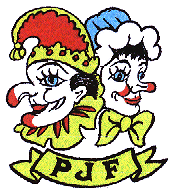THE WAY TO DO IT!
Summer holidays! what images do they
conjure in our minds? As a child growing up in the forties and early fifties summer holidays were usually spent at the seaside or even at home - in Southport. Yes, contrary to all the jokes, the sea does come in at Southport. I used to swim in it and in more recent times, the triple Grand National winner, Red
Rum trained on the beach by galloping through the shallows. I also had relatives
who lived in more fashionable resorts such as Torquay and Llandudno. My memories
of summer holidays consist of blue sea and blue skies, sunshine and golden
sands, of deckchairs and donkey rides, ice cream and candy floss, sand castles
and shrimping nets, rock pools and rounders -and of a small booth with a red and
white striped awning, usually surrounded by laughing children. From it could be
heard the immortal words "That’s the way to do it!" Mr Punch, who
else?
Red
Rum trained on the beach by galloping through the shallows. I also had relatives
who lived in more fashionable resorts such as Torquay and Llandudno. My memories
of summer holidays consist of blue sea and blue skies, sunshine and golden
sands, of deckchairs and donkey rides, ice cream and candy floss, sand castles
and shrimping nets, rock pools and rounders -and of a small booth with a red and
white striped awning, usually surrounded by laughing children. From it could be
heard the immortal words "That’s the way to do it!" Mr Punch, who
else?
My brother thought that Punch and Judy shows were wonderful. I must admit to finding Mr Punch quite frightening but I did like Dog Toby. Punch was violent and loud and not at all pleasant to his wife Judy and the baby. The poor policeman who used to attempt to intervene in their domestic disputes had a hard time of it, as well! I can’t quite remember the exact role of the crocodile and the function of the string of sausages now, I’m afraid.
Mr Punch, like many a puppet character of tradition, dates back to the wandering troupes of fourteenth century Italy, the Italian Commedia dell’ Arte. Then he was called Pulcinella and portrayed as a hook-nosed, cowardly buffoon. Down the centuries he merged with British glove puppet traditions and became Punchinello, or Mr Punch. He acquired his unfortunate wife Judy and by the end of the seventeenth century, the Punch and Judy show was well and truly established. Samuel Pepys’ description of a show at Covent Garden in 1662 is believed to be the first written record of a Punch and Judy performance and is commemorated by a plaque. Punch and Judy’s golden age was during the nineteenth century. Shows could be seen at country fairs, seaside resorts, in family parlours and in the streets of cities. Fans included all strata of society.
There were famous families of Punch performers or punchmen as they were sometimes called. One of these was the Codman family. Professor Richard Codman and his family lived in Norfolk in the early nineteenth century where there was an established tradition of wood carving and puppet manipulation. The Codmans travelled westwards in a horse drawn caravan taking their original wood carved puppets and performing wherever they stayed. They finally arrived in Liverpool and then later Llandudno where they were given permission to perform.
In Liverpool, their site was opposite Lime Street station and there they remained for many years. Various new developments threatened their existence and they had to move to a site next to St Georges’s Hall and then to Williamson Square. The family still perform, their present head being Ronald Codman. He was taught the art of manipulation and wood carving by his father and in turn is passing on his skills to his young son Robert. Elements in the show have altered over the years but the essence of the performance is much the same as ever. Ronald’s Dog Toby ‘sings’ to the strains of ‘Lily the Pink’. In 1962 several members of the Codman family were invited to unveil the afore-mentioned plaque and they are proud that their family name was used by Charles Dickens in ‘The Old Curiosity Shop’.
Another Punchman of note is Cumbria’s Dave Simpson who received his puppeting inspiration from ‘Blue Peter’. Having enjoyed Punch and Judy shows at the seaside as a child, he now performs all over Cumbria with puppets carved for him by Mary Edwards, the wife of one of Britain’s most famous Punch and Judy men, professor Glyn Edwards. Dave has tailored his act to modern requirements so, therefore, it is not quite as violent as in days gone by.
In 1841 Mr Punch became famous as the figurehead of a satirical magazine whose role was that of "defender of the oppressed and a radical scourge of authority". On May 1841 the first issue of ‘Punch’ rolled off the press. It survived, with a few hitches until May last year.
Rebecca Allison writing in another "scourge of the establishment" the Guardian newspaper, reported that Mohammed Al Fayed had regretfully had to close the magazine due to falling circulation. The archive and the library of 500,000 cartoons, however, survive and there is a website.
What is the secret of Mr Punch’s popularity? Pleasant he isn’t, kind and chivalrous he isn’t, and politically correct he most certainly isn’t! Perhaps that is the answer. Like the court jester before him, Punch is able to get away with appalling behaviour. Maybe he appeals to the anarchist in all of us - who knows? but he is still going strong, and when it comes to mastery of the art of continued popularity in an increasingly sophisticated and technological age, Mr Punch certainly knows the way to do it!
Barbara Hothersall